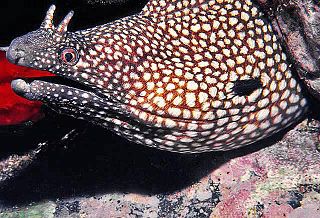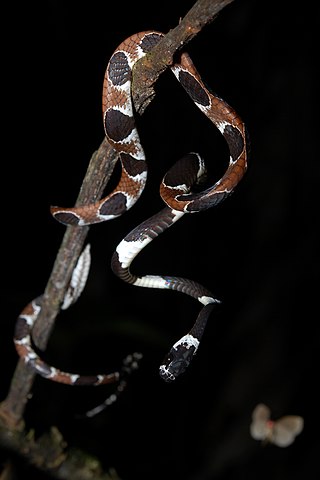
The black crowned crane is a part of the family Gruidae, along with its sister species, the grey crowned crane. It is topped with its characteristic bristle-feathered golden crown. It is usually found in the shallow wetlands of sub-Saharan Africa during the wet season, which act as its principal breeding, feeding and roosting sites although it can also be found foraging in grasslands and near croplands of dry savanna.

Dipsas variegata, the variegated snail-eater, is a snake found in South America. It is reported to feed almost exclusively on tree snails and slugs.

Dipsas indica, also known as the neotropical snail-eater, is a snake species found in South America. It feeds on slugs and snails, which the snake can extract from their shells using its slender jaw.

Muraena pavonina is a moray eel that occurs in the western and eastern Atlantic Ocean. It is found in holes and crevices at depth 2–60 m. This species has a maximum length of 51.2 cm (20.2 in).

Dipsas is a genus of nonvenomous New World snakes in the subfamily Dipsadinae of the family Colubridae. The genus Sibynomorphus has been moved here. Species of the genus Dipsas are known as snail-eaters.

Catesby's snail-eater, also commonly known as Catesby's snail sucker, is a nocturnal species of nonvenomous snake in the family Colubridae. The species is native to northern South America.
Dipsas pakaraima is an arboreal snake of the family Dipsadidae. It has been placed in the Dipsas temporalis group. It is native to medium and higher elevations in west-central Guyana. It has been collected in Kaieteur National Park and Mount Ayanganna. Its food probably consists of snails and slugs.
Dipsas pratti, known commonly as Pratt's snail-eater, is a species of arboreal snake in the subfamily Dipsadinae of the family Colubridae. The species is endemic to northern South America.
Jan's snail-eater, is a non-venomous snake found in Brazil.

Dipsas articulata, commonly known as the American snail-eater, is a non-venomous species of snake found in Nicaragua, Costa Rica and Panama.
Dipsas baliomelas is a non-venomous snake found in Colombia.
'''Dipsas copei is a non-venomous snake found in Guyana, Suriname, French Guiana, and Venezuela.
Dipsas lavillai is a non-venomous snake found in Argentina, Brazil, Paraguay, and Bolivia.
Dipsas neuwiedi, Neuwied's tree snake, is a non-venomous snake found in Brazil.
Dipsas nicholsi is a non-venomous snake found in Panama.
Dipsas peruana, the Peruvian snail-eater or Peru snail-eater, is a non-venomous snake found in Peru, Venezuela, and Colombia, Ecuador, and Bolivia.
Dipsas sazimai is a non-venomous snake found in Brazil.
Dipsas tenuissima, Taylor's snail-eater, is a non-venomous snake found in Panama and Costa Rica.
Dipsas vermiculata, the vermiculate snail-eater, is a non-venomous snake found in Ecuador, Peru, and Colombia.







